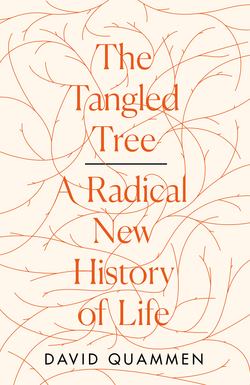Читать книгу The Tangled Tree: A Radical New History of Life - David Quammen, David Quammen - Страница 9
2
ОглавлениеWe don’t know whether Darwin sat back after writing that statement and breathed deep with a new sense of clarity, but he might have. And he was entitled.
Then he scribbled on. The tree is “irregularly branched,” he told the B notebook, “some branches far more branched.” Each branch diverges into smaller branches, he wrote, and then twigs, “Hence Genera,” the next higher category above species, which would be the twiglets or terminal buds. Some buds die away without yielding further growth—species extinction, end of a line—while new buds appear, somehow. Although the very idea of extinction had once been problematic among naturalists and philosophers, doubted as a possibility or rejected outright on grounds that God’s acts of special creation couldn’t be undone, Darwin recognized that there’s “nothing stranger in death of species” than in death of an individual. In fact, extinction was not just natural but necessary, making space for new species as old ones die away. He wrote: “The tree of life should perhaps be called the coral of life, base of branches dead,” ancestral forms gone. Darwin knew something about coral, having seen reefs at Keeling Atoll in the eastern Indian Ocean and elsewhere during the Beagle voyage. They fascinated him; he concocted a theory of how reefs are formed; and in 1842, five years after this notebook entry, he would publish a book about coral reefs. Coral seemed apt—branching coral, not brain coral or table coral, was what he had in mind—because the lower limbs and base are lifeless calcitic skeleton, left behind like extinct forms of ancient lineages as the soft polyps advance upward like living species. But even he seems to have sensed that “the coral of life” didn’t have the same memorable ring. He drew a feeble pen sketch, on page 26 in the B notebook, of a three-branched coral of life, with dotted lines depicting the inanimate lower sections. And then he let the coral idea slide, abandoning that metaphor.
The tree of life was better. It was already a venerable notion in 1837, and Darwin could adapt it to his purposes as an evolutionary theorist—easier than inventing a new trope from scratch. Of course, to make that adaptation was to alter its meaning radically. Never mind, he took the step. Ten notebook pages along, he sketched a much livelier and more complex figure in bold strokes, with a trunk rising into four major limbs and several minor ones, each major limb diverging into clusters of branches, one branch within each cluster labeled A, B, C, D. The branches B and C were near neighbors in the treetop, within adjacent clusters, indicating close relationships among the creatures on those branches. The letter A was far away, on the opposite side of the tree’s crown, signaling a more distant relationship—but still a relationship. The letters were placeholders, meant to represent living species, or maybe genera. Felis, Canis, Vulpes, Gorilla. We don’t know exactly what he had in mind, and maybe it was nothing so specific. Anyway, this was a thunderous assertion, abstract but eloquent. You can look at the little sketch today, with its four labeled branches amid the limbs and the crown, and imagine the evolutionary divergence of all life from a common ancestor.
Darwin’s 1837 sketch, redrawn by Patricia J. Wynne.
Just above the sketch, as though gesturing toward it bashfully, Darwin wrote: “I think.”
